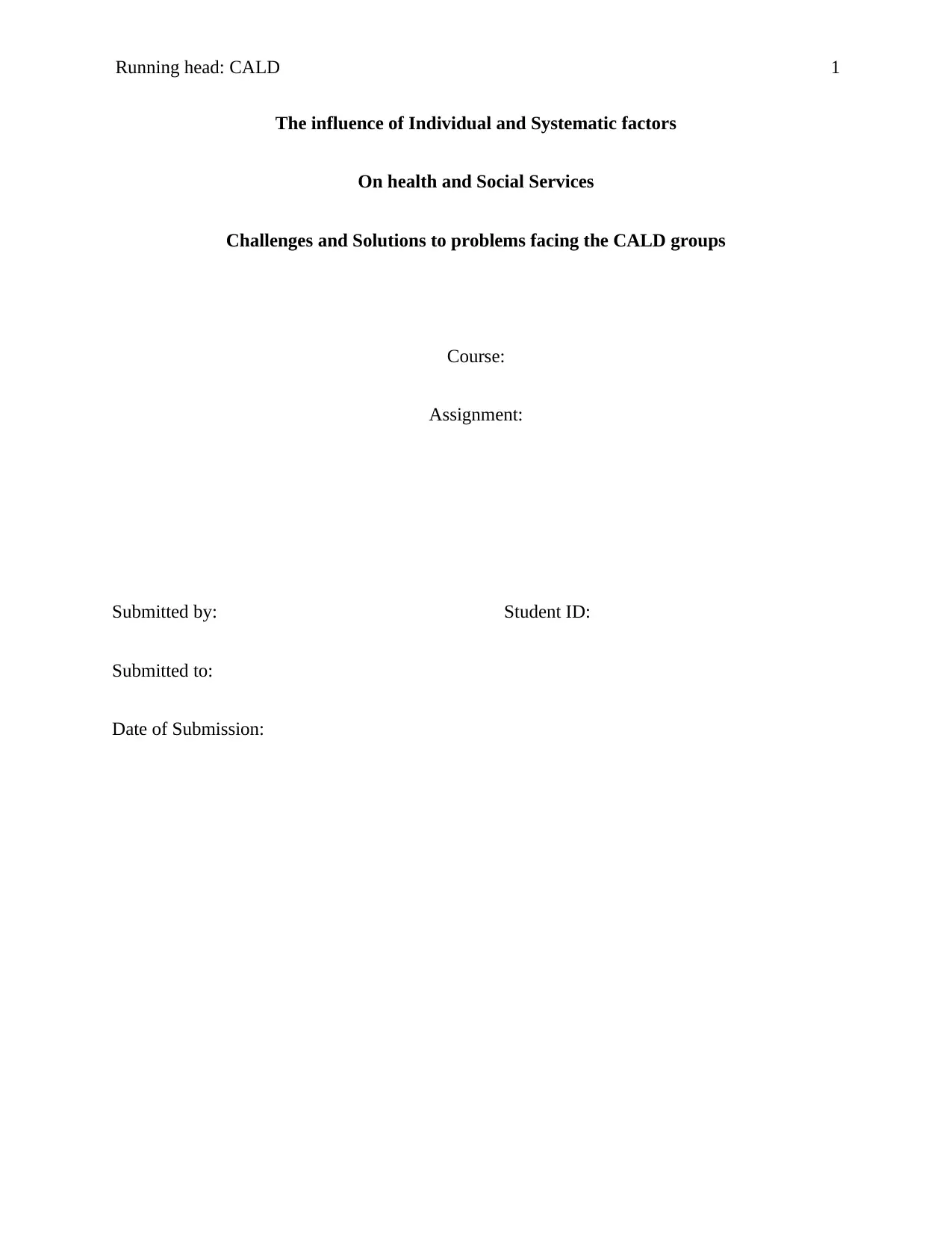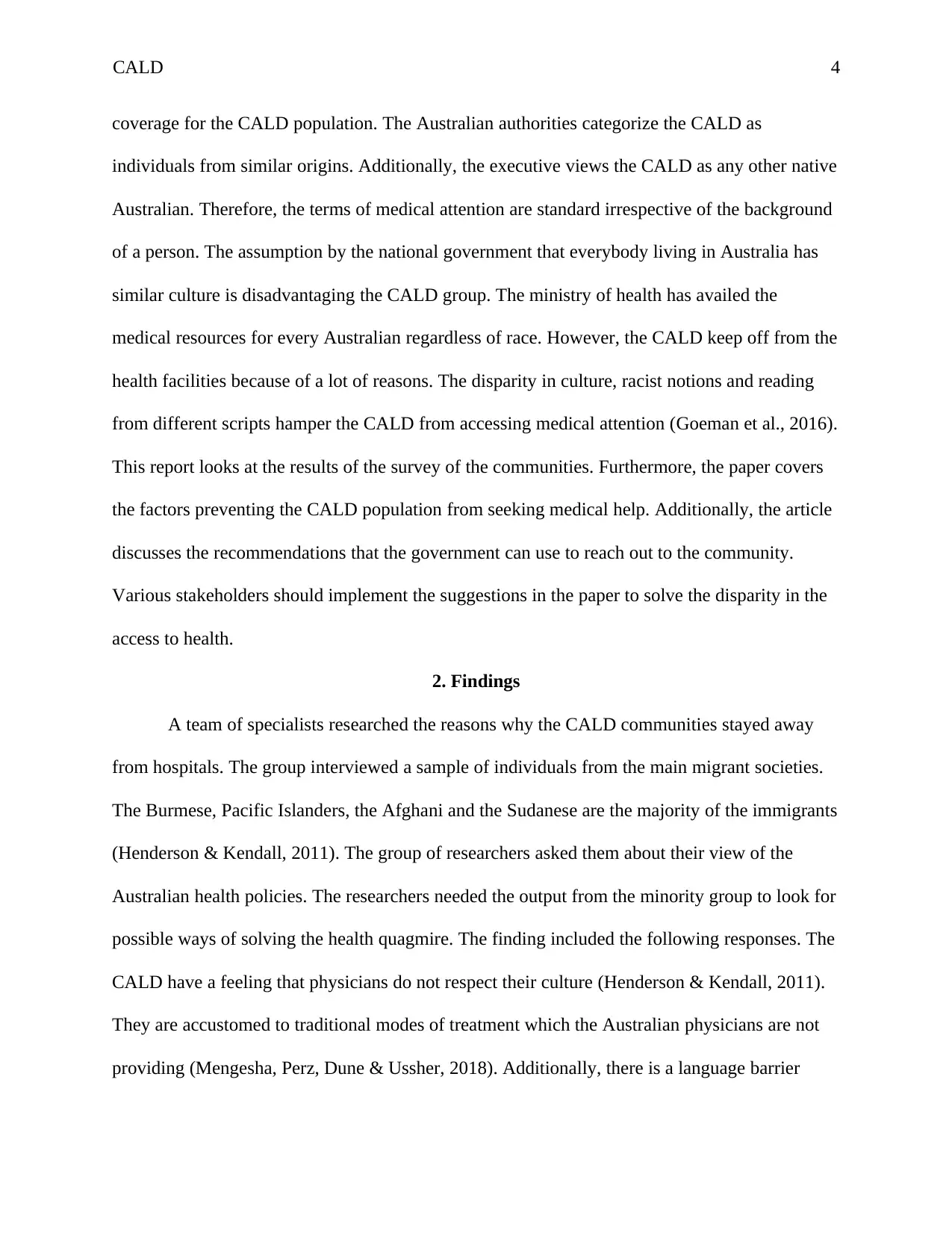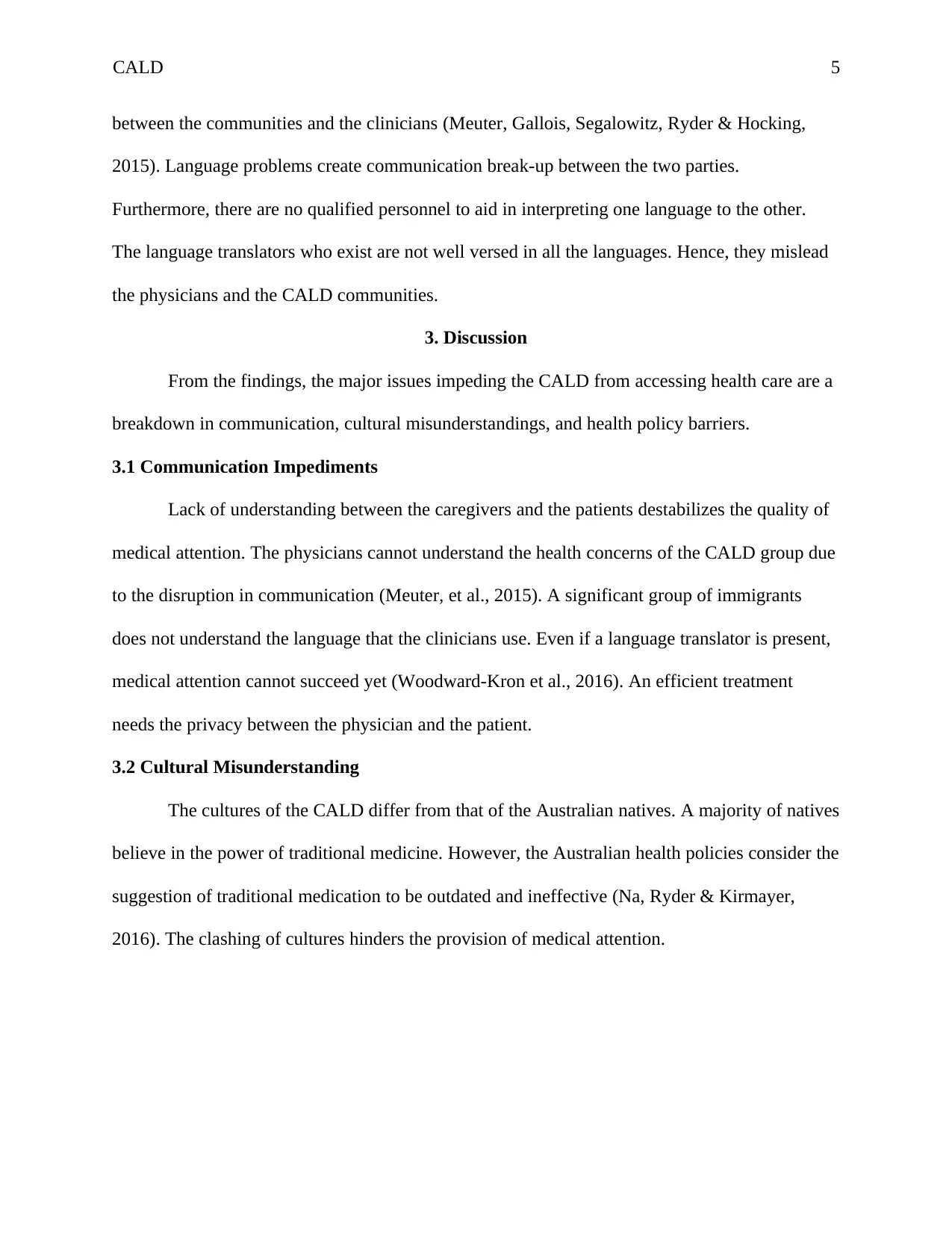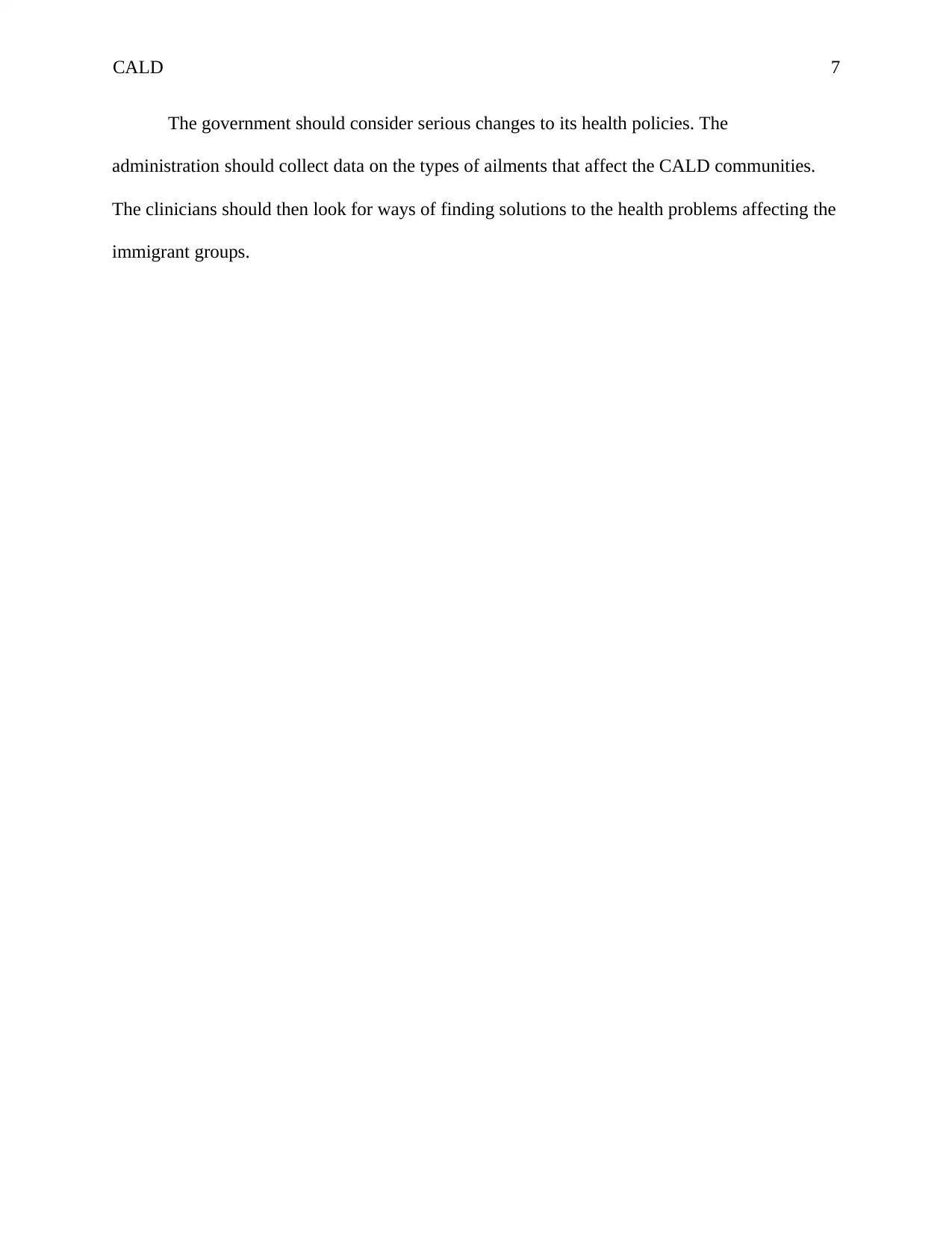The Culturally and Diverse Communities (CALD) in Australia
VerifiedAdded on 2021/06/16
|9
|1714
|41
AI Summary
Contribute Materials
Your contribution can guide someone’s learning journey. Share your
documents today.

Running head: CALD 1
The influence of Individual and Systematic factors
On health and Social Services
Challenges and Solutions to problems facing the CALD groups
Course:
Assignment:
Submitted by: Student ID:
Submitted to:
Date of Submission:
The influence of Individual and Systematic factors
On health and Social Services
Challenges and Solutions to problems facing the CALD groups
Course:
Assignment:
Submitted by: Student ID:
Submitted to:
Date of Submission:
Secure Best Marks with AI Grader
Need help grading? Try our AI Grader for instant feedback on your assignments.

CALD 2
Abstract
The culturally and Diverse Communities (CALD) in Australia migrate from different parts of the
world. A significant group of the CALD population lives in the Southern Part of Australia. These
communities are distinct in almost all aspects of their lives. CALD is composed of: those seeking
asylum, refugees, and immigrants. They have different ethnicity and mostly come from
undeveloped countries. The health records and status vary from one group of immigrants to the
next. The determinants of the distinctions in the state of health include place of birth, migration
methods, and ages of immigrants. Additional factors include competency in Australian English
and the levels of civilization at the origin of the migrant. The level of immunity of an individual
is another critical determinant. A significant number of migrants arrive in Australia when they
are healthy. However, the few unhealthy fellows infect them with airborne diseases. A study on
the CALD communities revealed the types of conditions that affect the populations. The
common ailments include malnutrition, malnutrition, and gastrointestinal disorders.
Table of Contents
Abstract
The culturally and Diverse Communities (CALD) in Australia migrate from different parts of the
world. A significant group of the CALD population lives in the Southern Part of Australia. These
communities are distinct in almost all aspects of their lives. CALD is composed of: those seeking
asylum, refugees, and immigrants. They have different ethnicity and mostly come from
undeveloped countries. The health records and status vary from one group of immigrants to the
next. The determinants of the distinctions in the state of health include place of birth, migration
methods, and ages of immigrants. Additional factors include competency in Australian English
and the levels of civilization at the origin of the migrant. The level of immunity of an individual
is another critical determinant. A significant number of migrants arrive in Australia when they
are healthy. However, the few unhealthy fellows infect them with airborne diseases. A study on
the CALD communities revealed the types of conditions that affect the populations. The
common ailments include malnutrition, malnutrition, and gastrointestinal disorders.
Table of Contents

CALD 3
1. Introduction..................................................................................................................................4
2. Findings.......................................................................................................................................5
3. Discussion....................................................................................................................................5
3.1 Communication Impediments................................................................................................6
3.2 Cultural Misunderstanding.....................................................................................................6
3.3. Barriers in health policy........................................................................................................6
4. Conclusion...................................................................................................................................6
5. Recommendations........................................................................................................................7
References........................................................................................................................................8
1. Introduction
The population of Australia consists of twenty-eight percent CALD communities
(Estrada & Messias, 2015). The department is health findings it hard to offer affordable health
1. Introduction..................................................................................................................................4
2. Findings.......................................................................................................................................5
3. Discussion....................................................................................................................................5
3.1 Communication Impediments................................................................................................6
3.2 Cultural Misunderstanding.....................................................................................................6
3.3. Barriers in health policy........................................................................................................6
4. Conclusion...................................................................................................................................6
5. Recommendations........................................................................................................................7
References........................................................................................................................................8
1. Introduction
The population of Australia consists of twenty-eight percent CALD communities
(Estrada & Messias, 2015). The department is health findings it hard to offer affordable health

CALD 4
coverage for the CALD population. The Australian authorities categorize the CALD as
individuals from similar origins. Additionally, the executive views the CALD as any other native
Australian. Therefore, the terms of medical attention are standard irrespective of the background
of a person. The assumption by the national government that everybody living in Australia has
similar culture is disadvantaging the CALD group. The ministry of health has availed the
medical resources for every Australian regardless of race. However, the CALD keep off from the
health facilities because of a lot of reasons. The disparity in culture, racist notions and reading
from different scripts hamper the CALD from accessing medical attention (Goeman et al., 2016).
This report looks at the results of the survey of the communities. Furthermore, the paper covers
the factors preventing the CALD population from seeking medical help. Additionally, the article
discusses the recommendations that the government can use to reach out to the community.
Various stakeholders should implement the suggestions in the paper to solve the disparity in the
access to health.
2. Findings
A team of specialists researched the reasons why the CALD communities stayed away
from hospitals. The group interviewed a sample of individuals from the main migrant societies.
The Burmese, Pacific Islanders, the Afghani and the Sudanese are the majority of the immigrants
(Henderson & Kendall, 2011). The group of researchers asked them about their view of the
Australian health policies. The researchers needed the output from the minority group to look for
possible ways of solving the health quagmire. The finding included the following responses. The
CALD have a feeling that physicians do not respect their culture (Henderson & Kendall, 2011).
They are accustomed to traditional modes of treatment which the Australian physicians are not
providing (Mengesha, Perz, Dune & Ussher, 2018). Additionally, there is a language barrier
coverage for the CALD population. The Australian authorities categorize the CALD as
individuals from similar origins. Additionally, the executive views the CALD as any other native
Australian. Therefore, the terms of medical attention are standard irrespective of the background
of a person. The assumption by the national government that everybody living in Australia has
similar culture is disadvantaging the CALD group. The ministry of health has availed the
medical resources for every Australian regardless of race. However, the CALD keep off from the
health facilities because of a lot of reasons. The disparity in culture, racist notions and reading
from different scripts hamper the CALD from accessing medical attention (Goeman et al., 2016).
This report looks at the results of the survey of the communities. Furthermore, the paper covers
the factors preventing the CALD population from seeking medical help. Additionally, the article
discusses the recommendations that the government can use to reach out to the community.
Various stakeholders should implement the suggestions in the paper to solve the disparity in the
access to health.
2. Findings
A team of specialists researched the reasons why the CALD communities stayed away
from hospitals. The group interviewed a sample of individuals from the main migrant societies.
The Burmese, Pacific Islanders, the Afghani and the Sudanese are the majority of the immigrants
(Henderson & Kendall, 2011). The group of researchers asked them about their view of the
Australian health policies. The researchers needed the output from the minority group to look for
possible ways of solving the health quagmire. The finding included the following responses. The
CALD have a feeling that physicians do not respect their culture (Henderson & Kendall, 2011).
They are accustomed to traditional modes of treatment which the Australian physicians are not
providing (Mengesha, Perz, Dune & Ussher, 2018). Additionally, there is a language barrier
Secure Best Marks with AI Grader
Need help grading? Try our AI Grader for instant feedback on your assignments.

CALD 5
between the communities and the clinicians (Meuter, Gallois, Segalowitz, Ryder & Hocking,
2015). Language problems create communication break-up between the two parties.
Furthermore, there are no qualified personnel to aid in interpreting one language to the other.
The language translators who exist are not well versed in all the languages. Hence, they mislead
the physicians and the CALD communities.
3. Discussion
From the findings, the major issues impeding the CALD from accessing health care are a
breakdown in communication, cultural misunderstandings, and health policy barriers.
3.1 Communication Impediments
Lack of understanding between the caregivers and the patients destabilizes the quality of
medical attention. The physicians cannot understand the health concerns of the CALD group due
to the disruption in communication (Meuter, et al., 2015). A significant group of immigrants
does not understand the language that the clinicians use. Even if a language translator is present,
medical attention cannot succeed yet (Woodward-Kron et al., 2016). An efficient treatment
needs the privacy between the physician and the patient.
3.2 Cultural Misunderstanding
The cultures of the CALD differ from that of the Australian natives. A majority of natives
believe in the power of traditional medicine. However, the Australian health policies consider the
suggestion of traditional medication to be outdated and ineffective (Na, Ryder & Kirmayer,
2016). The clashing of cultures hinders the provision of medical attention.
between the communities and the clinicians (Meuter, Gallois, Segalowitz, Ryder & Hocking,
2015). Language problems create communication break-up between the two parties.
Furthermore, there are no qualified personnel to aid in interpreting one language to the other.
The language translators who exist are not well versed in all the languages. Hence, they mislead
the physicians and the CALD communities.
3. Discussion
From the findings, the major issues impeding the CALD from accessing health care are a
breakdown in communication, cultural misunderstandings, and health policy barriers.
3.1 Communication Impediments
Lack of understanding between the caregivers and the patients destabilizes the quality of
medical attention. The physicians cannot understand the health concerns of the CALD group due
to the disruption in communication (Meuter, et al., 2015). A significant group of immigrants
does not understand the language that the clinicians use. Even if a language translator is present,
medical attention cannot succeed yet (Woodward-Kron et al., 2016). An efficient treatment
needs the privacy between the physician and the patient.
3.2 Cultural Misunderstanding
The cultures of the CALD differ from that of the Australian natives. A majority of natives
believe in the power of traditional medicine. However, the Australian health policies consider the
suggestion of traditional medication to be outdated and ineffective (Na, Ryder & Kirmayer,
2016). The clashing of cultures hinders the provision of medical attention.

CALD 6
3.3. Barriers to health policy
Policy barriers involve a poor health culture by the health practitioners. The Australian
administration is unaware of health concerns of the CALD groups (Pound & Greenwood, 2016).
Additionally, the health department lacks efficient modes of language translations.
4. Conclusion
The Australian government should conceder appropriate recommendations to solve the
healthcare problems affecting the CALD groups. The CALD stay away from health facilities due
to some reasons. The migrant's groups feel that the healthcare methods are racist. The CALD
also suffer to the clash in culture between the native Australians and themselves. Additionally,
there is a communication break up between the natives and migrants. The migrants believe in
traditional medicine as opposed to the Australian government which beliefs in modern
medication. Migrants are not fluent in spoken English which the clinicians use during treatment.
Finally, the Australian Health Policy lacks methods to counter the effects of language barriers.
5. Recommendations
The Australian government should train language translators to assist the CALD group
who do not understand the English language. The translators should be present at all point of
medical attention. The management of health facilities should ensure that the CALD patients can
easily and freely access the services of a language interpreter.
On the issue of cultural misunderstanding, the national administration should make their
services to be flexible. The health practitioners should do conclusive research on traditional
modes of treatment. Additionally, the physicians should integrate those forms of medical
attention with the modern ways of healthcare provision. Physicians should grant the wishes of
the CALD however impossible; they may seem.
3.3. Barriers to health policy
Policy barriers involve a poor health culture by the health practitioners. The Australian
administration is unaware of health concerns of the CALD groups (Pound & Greenwood, 2016).
Additionally, the health department lacks efficient modes of language translations.
4. Conclusion
The Australian government should conceder appropriate recommendations to solve the
healthcare problems affecting the CALD groups. The CALD stay away from health facilities due
to some reasons. The migrant's groups feel that the healthcare methods are racist. The CALD
also suffer to the clash in culture between the native Australians and themselves. Additionally,
there is a communication break up between the natives and migrants. The migrants believe in
traditional medicine as opposed to the Australian government which beliefs in modern
medication. Migrants are not fluent in spoken English which the clinicians use during treatment.
Finally, the Australian Health Policy lacks methods to counter the effects of language barriers.
5. Recommendations
The Australian government should train language translators to assist the CALD group
who do not understand the English language. The translators should be present at all point of
medical attention. The management of health facilities should ensure that the CALD patients can
easily and freely access the services of a language interpreter.
On the issue of cultural misunderstanding, the national administration should make their
services to be flexible. The health practitioners should do conclusive research on traditional
modes of treatment. Additionally, the physicians should integrate those forms of medical
attention with the modern ways of healthcare provision. Physicians should grant the wishes of
the CALD however impossible; they may seem.

CALD 7
The government should consider serious changes to its health policies. The
administration should collect data on the types of ailments that affect the CALD communities.
The clinicians should then look for ways of finding solutions to the health problems affecting the
immigrant groups.
The government should consider serious changes to its health policies. The
administration should collect data on the types of ailments that affect the CALD communities.
The clinicians should then look for ways of finding solutions to the health problems affecting the
immigrant groups.
Paraphrase This Document
Need a fresh take? Get an instant paraphrase of this document with our AI Paraphraser

CALD 8
References
Estrada, R. D., & Messias, D. K. H. (2015). A scoping review of the literature: content, focus,
conceptualization, and application of the national standards for culturally and
linguistically appropriate services in health care. Journal of health care for the poor and
underserved, 26(4), 1089-1109.
Goeman, D., Michael, J., King, J., Luu, H., Emmanuel, C., & Koch, S. (2016). Partnering with
consumers to develop and evaluate a Vietnamese Dementia Talking-Book to support low
health literacy: a qualitative study incorporating codesign and participatory action
research. BMJ Open, 6(9), e011451.
Henderson, S., & Kendall, E. (2011). Culturally and linguistically diverse peoples' knowledge of
accessibility and utilization of health services: exploring the need for improvement in
health service delivery. Australian journal of primary health, 17(2), 195-201.
Mengesha, Z. B., Perz, J., Dune, T., & Ussher, J. (2018). Talking about sexual and reproductive
health through interpreters: the experiences of health care professionals consulting
refugee and migrant women. Sexual & Reproductive Healthcare.
Meuter, R. F., Gallois, C., Segalowitz, N. S., Ryder, A. G., & Hocking, J. (2015). Overcoming
language barriers in healthcare: A protocol for investigating safe and effective
communication when patients or clinicians use a second language. BMC health services
research, 15(1), 371.
Na, S., Ryder, A. G., & Kirmayer, L. J. (2016). Toward a Culturally Responsive Model of
Mental Health Literacy: Facilitating Help‐Seeking Among East Asian Immigrants to
North America. American journal of community psychology, 58(1-2), 211-225.
References
Estrada, R. D., & Messias, D. K. H. (2015). A scoping review of the literature: content, focus,
conceptualization, and application of the national standards for culturally and
linguistically appropriate services in health care. Journal of health care for the poor and
underserved, 26(4), 1089-1109.
Goeman, D., Michael, J., King, J., Luu, H., Emmanuel, C., & Koch, S. (2016). Partnering with
consumers to develop and evaluate a Vietnamese Dementia Talking-Book to support low
health literacy: a qualitative study incorporating codesign and participatory action
research. BMJ Open, 6(9), e011451.
Henderson, S., & Kendall, E. (2011). Culturally and linguistically diverse peoples' knowledge of
accessibility and utilization of health services: exploring the need for improvement in
health service delivery. Australian journal of primary health, 17(2), 195-201.
Mengesha, Z. B., Perz, J., Dune, T., & Ussher, J. (2018). Talking about sexual and reproductive
health through interpreters: the experiences of health care professionals consulting
refugee and migrant women. Sexual & Reproductive Healthcare.
Meuter, R. F., Gallois, C., Segalowitz, N. S., Ryder, A. G., & Hocking, J. (2015). Overcoming
language barriers in healthcare: A protocol for investigating safe and effective
communication when patients or clinicians use a second language. BMC health services
research, 15(1), 371.
Na, S., Ryder, A. G., & Kirmayer, L. J. (2016). Toward a Culturally Responsive Model of
Mental Health Literacy: Facilitating Help‐Seeking Among East Asian Immigrants to
North America. American journal of community psychology, 58(1-2), 211-225.

CALD 9
Pound, C., & Greenwood, N. (2016). The human dimensions of post-stroke homecare:
experiences of older carers from diverse ethnic groups. Disability and rehabilitation,
38(20), 1987-1999.
Woodward-Kron, R., Hughson, J. A., Parker, A., Bresin, A., Hajek, J., Knoch, U., ... & Story, D.
(2016). Culturally and linguistically diverse populations in medical research: perceptions
and experiences of older Italians, their families, ethics administrators and researchers.
Journal of public health research, 5(1).
Pound, C., & Greenwood, N. (2016). The human dimensions of post-stroke homecare:
experiences of older carers from diverse ethnic groups. Disability and rehabilitation,
38(20), 1987-1999.
Woodward-Kron, R., Hughson, J. A., Parker, A., Bresin, A., Hajek, J., Knoch, U., ... & Story, D.
(2016). Culturally and linguistically diverse populations in medical research: perceptions
and experiences of older Italians, their families, ethics administrators and researchers.
Journal of public health research, 5(1).
1 out of 9
Related Documents
Your All-in-One AI-Powered Toolkit for Academic Success.
+13062052269
info@desklib.com
Available 24*7 on WhatsApp / Email
![[object Object]](/_next/static/media/star-bottom.7253800d.svg)
Unlock your academic potential
© 2024 | Zucol Services PVT LTD | All rights reserved.





